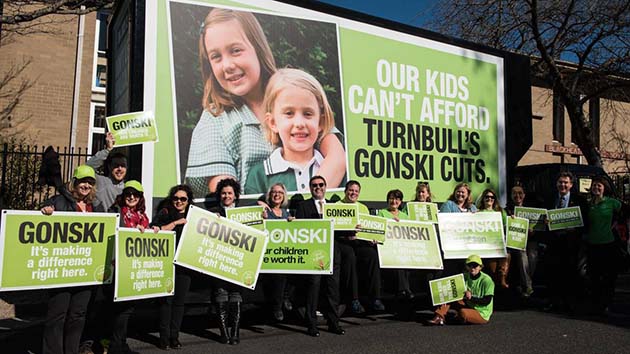Malcolm Turnbull presented his Gonski 2.0 package as a breakthrough delivering a significant funding boost for schools. This is an enormous con. It locks in significantly higher funding for private schools even than the original Gonski deal.
The Greens were wrong to enter negotiations with Turnbull and offer their support. This only helped the government pretend its package was reasonable. Greens Senator Lee Rhiannon was right to oppose it. Eventually, The Greens did end up voting against the package, after Turnbull secured the votes he needed to pass it from the Senate crossbenchers instead.
Under Turnbull’s deal, private schools will actually get more new funding than goes to public schools. Private school funding is up by $9.3 billion compared to just $8.7 billion for the public system. This is significantly worse than the existing Gonski funding deal, which at least ensured public schools received 80 per cent of the extra funding when fully implemented.
Gonski 2.0 will see the federal government fund 80 per cent of private schools’ School Resourcing Standard (SRS) compared to just 20 per cent for public schools. The changes also abolish the existing provision for federal funding to increase until schools reach their full SRS. As a result most public schools will never reach 100 per cent of the SRS.
A school’s SRS requirement is designed to allow them to get 80 per cent of students to satisfy NAPLAN standards, with extra funding based on socio-economic status and student disadvantage.
The state governments currently fund the bulk of public schools’ needs, mostly providing a level around 70 per cent of SRS. They will now have to move towards 75 per cent, but there is no requirement to ever get funding to the full amount.
The Turnbull government is simply handing the funding problem to the states. Education Minister Simon Birmingham has made clear that the funding level, “is a matter of policy priorities for them.”
But private schools will get more than their full allocation. State governments also give funding to private schools. In Victoria for instance, the effect of combined federal and state funding will now provide them 105 per cent of the SRS.
Needs-based funding?
Both versions of Gonski claimed to be “sector blind”, funding all schools on the basis of need. But this was always wrong as a funding principle. Guaranteeing funding to public and private schools alike only maintains the existing inequality between schools.
The original Gonski plan maintained state funding for private schools, and entrenched the narrow focus on NAPLAN scores. But Gonski 2.0 doesn’t even pretend to fiddle with inequality.
Total funding to non-government schools is well over $12 billion per year, making up 70 per cent of income for Catholic schools and over 40 per cent across other private schools. Government funding more than covers the total Catholic school wages bill. The government should either take over private schools or cease funding them.
Private schools losing money?
The government’s claim that private schools would lose money under the new deal, along with Catholic school opposition to it, has been a source of confusion. But there are only 24 elite schools around Australia that will lose a small amount of funding.
Most “independent” private schools will gain—which is why the sector has embraced the deal. Elite private schools including Caulfield Grammar, Wesley College and Scotch College in Melbourne and The King’s School and Newington College in Sydney will get a funding boost. The percentage of independent schools funded above their SRS will increase from 17 to 65 per cent.
Exactly what Gonski 2.0 will mean state to state, and school to school, remains unclear. But Labor’s Tanya Plibersek may well be right that public schools in Tasmania and the Northern Territory will be worse off. The Coalition plan will deliver $17 billion less than Labor had committed over the next decade.
The Australian Education Union has rightly opposed Gonski 2.0, but its campaign for “Gonski funding” has been badly damaged. David Gonski’s backing for Turnbull’s plan has exposed the flaws that were always built into the Gonski model. “Needs-based funding for all schools” was code for continuing to fund private schools.
Well-funded public schools could reduce class sizes, increase teacher preparation time, and reduce social segregation. Government funding of private schools is a hand-out from workers to the rich that increases inequality—it must end. The relentless narrow competition that NAPLAN and the My School website foster also drives inequality, and must be opposed. We need an industrial campaign for public education. Public rallies organised by the education unions to oppose Gonski 2.0 and demand public funding for public schools would be a good start.
By Chris Breen






